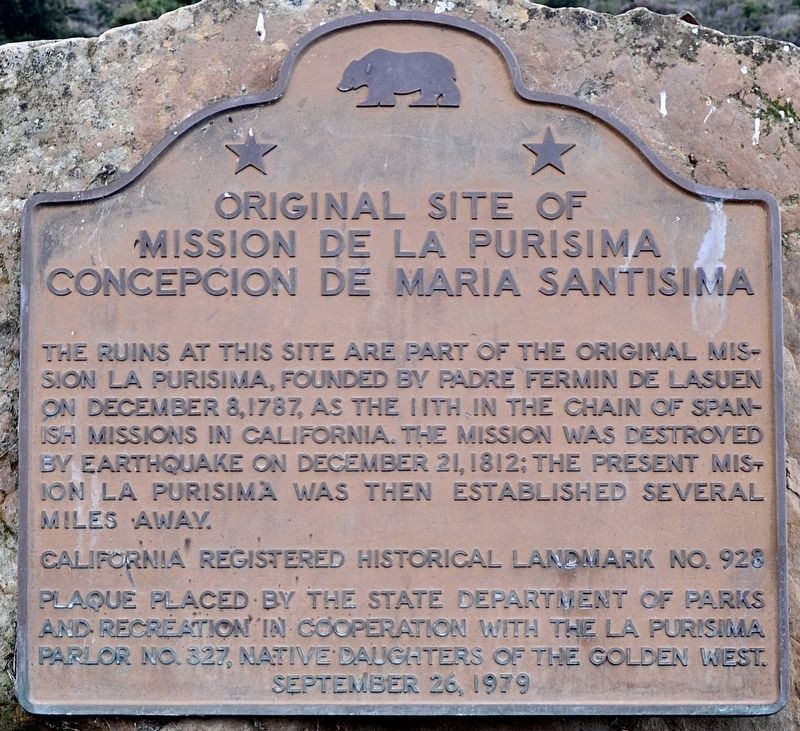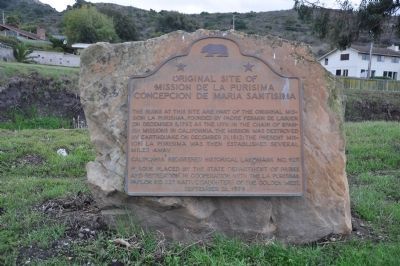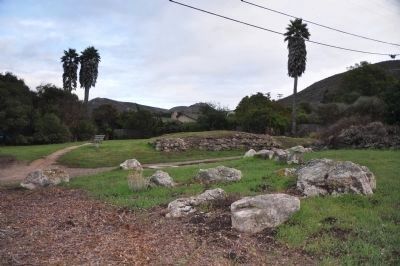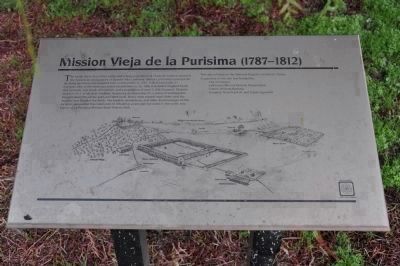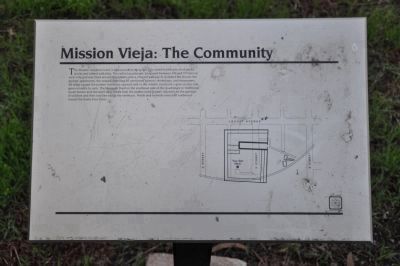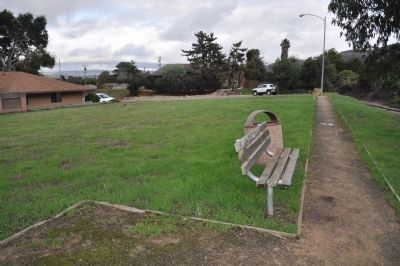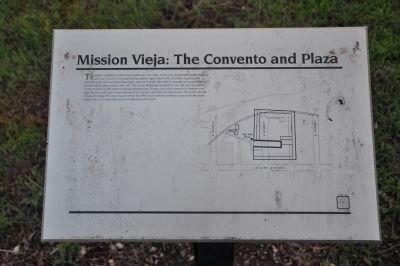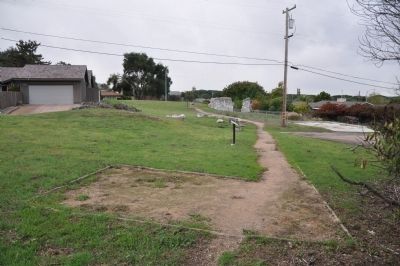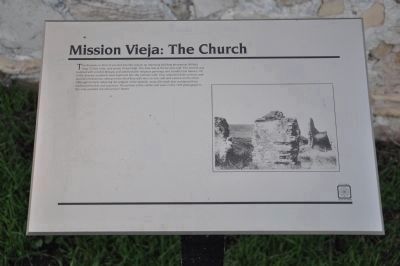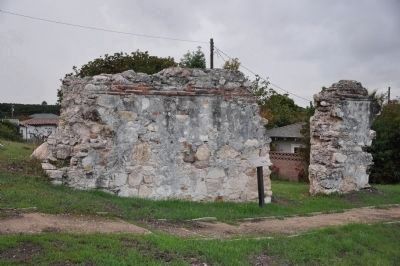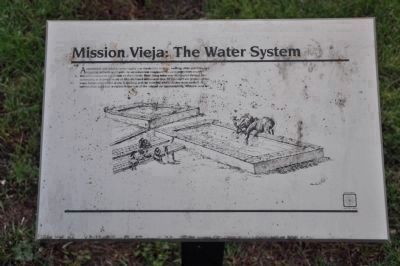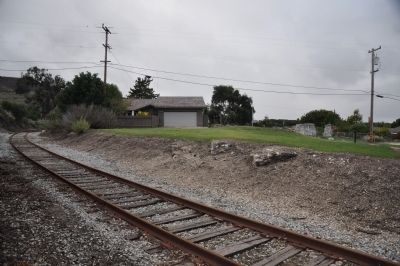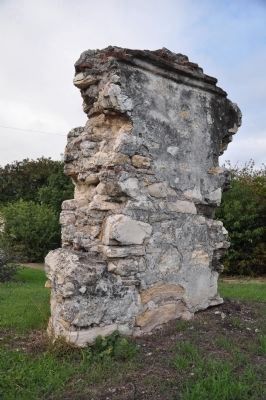Lompoc in Santa Barbara County, California — The American West (Pacific Coastal)
Original Site of Mission de La Purisima Concepcion de Maria Santisima
Along a walking trail through the site, interpretive panels are placed detailing the history of the Mission:
panel 1:
Mission Vieja de la Purisima (1787-1812)
The fertile Santa Ynez River valley and a large population of Chumash Indians attracted the Franciscan missionaries of Spanish Alta California. Mission La Purisima Concepcion de Maria Santisima was founded here on December 8, 1787, 11th of eventually 21 missions. One of the more successful establishments, but 1806 it included irrigated fields and orchards, vast herds of livestock, and a population of over 11,000 Chumash. Disaster struck in 1812, el Ano de Los Temblores. Beginning on December 21, a series of earthquakes brought down the adobe walls and tiled roofs, heavy rains caused mud slides, and the swollen river flooded the fields. The terrible devastation, and other disadvantages of this location, persuaded the community to rebuild at a new site five miles to the north, now known as La Purisima Mission State Historic Park.
panel 2:
Mission Vieja: The Community
The Mission residents lived in and around an enclosed four-sided building built of adobe bricks and roofed with tiles. The central quadrangle measured between 300 and 375 feet on each side and was lined around the interior with a covered walkway. It included the church, the padres apartments, the monjario (dwelling for unmarried women), workshops, and storerooms. All wings except the padres' residence opened only to the interior courtyard; a gate on one side gave entrance to carts. The Chumash lived on the southeast side of the quadrangle in traditional brush homes and obtained daily meals from the pozolera (cook house). Quarters for the garrizon of soldiers and their families was to the northwast. Fields and orchards stretched northward toward the Santa Ynez River.
panel 3:
Mission Vieja: The Convento and Plaza
The padres' residence which was located on your right, is the only quadrangle wing to have a double row of rooms. It contained the padres' apartments with a kitchen, a public sala (sitting room), and accommodations for visitors. A wide, tile-roofed veranda ran along the front bordering the plaza area to the east. The plaza, which was located to your left, was the social center of mission life where religious celebrations, fiestas, and other community events were held. To the north was the residence of the soldiers and their families and to the south was the Chumash village. El Camino Real entered from the east and linked Mission Vieja with Missions Santa Ines to the east and San Luis Obispo to the north.
panel 4:
Mission Vieja: The Church
The doorway in front of you led into the church, an imposing building measuring 100 feet long, 52 feet wide, and nearly 30 feet high. The altar was at the far west end. The interior was painted with colorful designs and adorned with religious paintings and statues from Mexico. All of the mission residents were baptized into the Catholic faith. They attended daily services and special celebrations, sitting on the tiled floor with men on one side and women on the other. Although formally adopting the regligion of the Spanish, many Chumash also continued their traditional beliefs and practices. The portion of the adobe wall seen in this 1905 photograph is the vine-covered mound across F Street.
panel 5:
Mission Vieja: The Water System
A convenient and reliable water supply was needed for cooking, washing, shop activities, and irrigating orchards and fields. An aqueduct was constructed to carry water from nearby Miguelito Canyon to a reservoir on the hillside. From there water was distributed through the community in channels made of lime-mortared stones and tiles. To your right are remains of two water basins and in front of you is the the long and low lavanderia where clothes were washed. A section of an aqueduct is visible in the side of the railroad cut approximately 50 feet to your left.
Erected 1979 by State Department of Parks and Recreation in cooperation with the La Purisima Parlors No. 327, Native Daughters of the Golden West. (Marker Number 928.)
Topics and series. This historical marker is listed in these topic lists: Churches & Religion
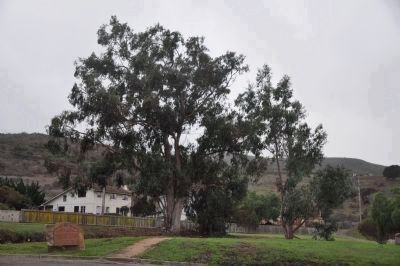
Photographed By Michael Kindig, November 23, 2010
3. Mission Vieja de la Purisima (1787-1812)
This site is listed on the National Register of Historic Places. Acquisition of this site was funded by:
City of Lompoc
California Office of Historic Preservation
County of Santa Barbara
Donation from Frank M. and Emily Signorelli
City of Lompoc
California Office of Historic Preservation
County of Santa Barbara
Donation from Frank M. and Emily Signorelli
Location. 34° 37.889′ N, 120° 27.328′ W. Marker is in Lompoc, California, in Santa Barbara County. Marker is on South F Street south of East Locust Avenue. Touch for map. Marker is at or near this postal address: 537 South F Street, Lompoc CA 93436, United States of America. Touch for directions.
Other nearby markers. At least 8 other markers are within 6 miles of this marker, measured as the crow flies. Tragedy of Point Pedernales / Honda Point (approx. 0.2 miles away); Lompoc's Mission Vieja (approx. 0.4 miles away); Lompoc World War I Monument (approx. 0.4 miles away); Italian Stone Pines (approx. 0.4 miles away); Lompoc Carnegie Library (approx. 0.4 miles away); La Purisima Mission State Historic Park (approx. 3.4 miles away); La Purisima Mission (approx. 3.8 miles away); a different marker also named La Purisima Mission (approx. 5.6 miles away). Touch for a list and map of all markers in Lompoc.
Related marker. Click here for another marker that is related to this marker. - Artifact from the old mission.
Credits. This page was last revised on March 24, 2022. It was originally submitted on December 15, 2011, by Michael Kindig of Elk Grove, California. This page has been viewed 1,805 times since then and 94 times this year. Photos: 1. submitted on March 17, 2022. 2, 3. submitted on December 15, 2011, by Michael Kindig of Elk Grove, California. 4. submitted on December 29, 2011, by Michael Kindig of Elk Grove, California. 5, 6, 7, 8, 9, 10, 11, 12, 13. submitted on December 15, 2011, by Michael Kindig of Elk Grove, California. 14. submitted on December 29, 2011, by Michael Kindig of Elk Grove, California. • Syd Whittle was the editor who published this page.
